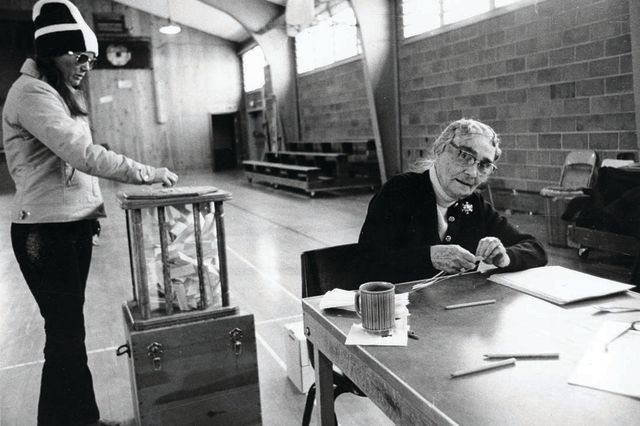Aspen PEO Celebrates 100 Years of Quietly Building Community

Current members of Aspen PEO.
Image: Courtesy: Aspen PEO
In January 1869, seven women attending Iowa Wesleyan College decided to buck the traditional sorority system and impulsively created an alternate type of organization, one that celebrated women’s intellect and encouraged the development of their talent. PEO (commonly known as Philanthropic Educational Organization) was born.
During Aspen’s “Quiet Years,” those after the silver boom and before the recreational skiing industry took hold, a group of stalwart women met regularly as the Shakespeare Club. In 1913, they branched away from the Bard, calling themselves the Aspen Reading Club. Within a few years, dissatisfied with strictly discussing literature, they applied to become a chapter of PEO. On December 1, 1917, the 12 members of the Aspen Reading Club became PEO, Chapter AR. Over the past 100 years, the Aspen PEO sisters (which include this writer) have quietly helped improve the town they loved, assisting countless women in continuing their education.
From its humble beginnings in 1869 to the present, PEO has grown to 252,000 active members nationally. In Colorado alone there are more than 240 chapters and 10,410 members. As of 2016, PEO has awarded $283 million to more than 99,000 recipients. So why have most people never heard of the organization?
“When PEO was formed, and later in 1917 when the Aspen chapter was founded, women were not supposed to fraternize for special causes,” says Aspen PEO member Barbara Bakios-Wickes. “It was accepted for women to gather to knit, bake, or take care of children. Because of that private way the organization was founded, we never discussed PEO in public, only with other members of the sisterhood.”
Like many other invitation-only service organizations, PEO has its traditions that create a bond among members. But the organization stuck to its original practices even as the role of women in society changed. Getting younger members, who were taking care of children or working full time, became difficult. About 10 years ago it unveiled the “It’s OK to talk about PEO” campaign, encouraging members to spread the word about the group’s mission.

Aspen PEO member Maude Twining also served as an election judge in 1974.
Aspen PEO member Sue Griffith, who joined her mother’s chapter in 1961, remembers that in those early days, even PEO’s monthly magazine, The Record, was mailed in a secure envelope. “But now we do talk about it, especially all the great things we’re trying to accomplish,” she says.
In the early days, PEO members nationally threw themselves into raising money for sundry local needs like hospital beds, microscopes for high schools, and glasses for needy students, but most efforts went toward education.
Today the focus remains on raising funds for national and international scholarships and low-interest loan programs. The organization also finances Cottey College, an all-women liberal arts school in Missouri. But the Aspen chapter actively aims to help women from the community achieve their educational goals. Since the early 1990s it’s helped fund four to five local women each year.
“PEO is different from other scholarship-granting organizations,” says Robin Van Domelen, chair of Aspen PEO’s Scholarship Committee. “We want to get to know these women. We keep in contact with them throughout their educational journeys, writing them letters, sending little gifts, and inviting them to some of our social events.”
Lisa May Howard was working part time and raising twin girls in Aspen in the early ’90s when she received a low-interest loan from PEO and was able to get a degree in elementary education. Now she plans to apply for a second loan to get a master’s degree in library science. “Both my girls receive scholarships from the local PEO chapter, too,” she says. “This has been critical for my family.”
As the Aspen chapter celebrates its centennial, members are taking a look back as they prepare to move forward. Says PEO Chapter AR president Susan Casebeer, “It has been humbling and quite a history lesson to go back and read the minutes from our chapter starting in 1917. PEO raised funds and awareness during both World Wars, helped women start or continue their educations, and advocated for early bills in Congress to stop child labor.”
Even as women no longer have to meet in secret to work toward making an impact, PEO’s strong belief in the power of service to community—and especially education—keeps the organization relevant, in Aspen and beyond.
Do You Know Who Was PEO? Over its 100-year-and-counting life span, the Aspen chapter has attracted many prominent local women, including these five notables.
Frances Willoughby Herron: Daughter of Midnight Mine owner and Aspen mayor Fred Willoughby, Frances was an active violin player in the community orchestra. She and her husband, John, led the community effort to maintain the Aspen Music Festival and School in the early 1950s.
Hettie Kobey: She and her husband, Benjamin, owned the Kobey Shoe and Clothing store at 421 E. Hyman Ave. in the early 20th century.
Peggy Rowland: This third-generation Aspenite’s mother was Fleeta Lamb Cooper, one of the original 12 local PEO members. Peggy served as Pitkin County Superintendent of Schools and the Colorado PEO state president.
Alice Rachel Sardy: She and her husband came to Aspen in 1938 after buying the Aspen Hardware and Supply store and the mortuary. The Sardys worked tirelessly to raise money and advocate for a new airport (what’s now Sardy Field).
Maude Twining: From 1914 to 1919, she taught English and coached girls basketball at the high school and later, with her husband, Dr. Warren “Doc” Twining, saved Aspen Valley Hospital from bankruptcy.













































